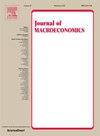Borrowing constraints, financial frictions, misallocation and GDP per worker
IF 1.5
3区 经济学
Q3 ECONOMICS
引用次数: 0
Abstract
The aim of this paper is to analyze the effect of relaxing borrowing constraints taking into account that firms may be facing either earnings-based or asset-based borrowing constraints on some aggregates such GDP per worker or TFP. We also analyze the impact on those aggregates of increasing the proportion of firms with earnings-based borrowing constraints. Using the World Bank Enterprise Survey, we show that the proportion of firms whose loans require collateral is lower in those countries whose bankruptcy laws facilitate reorganization. In addition, we show that there are no significant differences in the median/average contract-enforcement scores between countries where bankruptcy laws facilitate reorganization and countries where they do not, and that there is a significant negative link between the contract-enforcement score and the collateral-to-loan ratio. Furthermore, we also show that there is a significant positive correlation between the average proportion of firms in a country whose credit does not require collateral (with cash flow-based debt) with GDP per worker and TFP, but not with the debt-to-GDP ratio. We build a model that takes into account country characteristics in the proportion of firms whose loans require collateral and also in the average collateral-to-loan ratio. We find that policies aimed at increasing the proportion of firms that face borrowing constraints based on earnings rather than on assets, so as to reduce the misallocation of debt, may be as important as those aimed at reducing the collateral-to-loan ratio.
借贷限制、金融摩擦、分配不当和人均GDP
本文的目的是分析放松借贷限制的影响,同时考虑到企业可能面临基于收入或基于资产的某些总量(如人均GDP或TFP)的借贷限制。我们还分析了增加以盈利为基础的借款限制的企业比例对这些总量的影响。利用世界银行企业调查,我们发现在那些破产法有利于重组的国家,贷款需要抵押品的企业比例较低。此外,我们表明,在破产法有利于重组的国家和破产法不利于重组的国家之间,合同执行得分的中位数/平均值没有显著差异,合同执行得分与抵押贷款比之间存在显著的负相关。此外,我们还表明,在一个国家,信贷不需要抵押品(以现金流为基础的债务)的企业的平均比例与人均GDP和TFP之间存在显著的正相关关系,但与债务与GDP之比无关。我们建立了一个模型,该模型考虑了各国在贷款需要抵押品的企业比例和平均抵押贷款比率方面的特点。我们发现,旨在增加基于收益而非资产而面临借款限制的企业比例的政策,以减少债务的错配,可能与旨在降低抵押贷款比的政策同样重要。
本文章由计算机程序翻译,如有差异,请以英文原文为准。
求助全文
约1分钟内获得全文
求助全文
来源期刊

Journal of Macroeconomics
ECONOMICS-
CiteScore
2.50
自引率
7.10%
发文量
53
审稿时长
76 days
期刊介绍:
Since its inception in 1979, the Journal of Macroeconomics has published theoretical and empirical articles that span the entire range of macroeconomics and monetary economics. More specifically, the editors encourage the submission of high quality papers that are concerned with the theoretical or empirical aspects of the following broadly defined topics: economic growth, economic fluctuations, the effects of monetary and fiscal policy, the political aspects of macroeconomics, exchange rate determination and other elements of open economy macroeconomics, the macroeconomics of income inequality, and macroeconomic forecasting.
 求助内容:
求助内容: 应助结果提醒方式:
应助结果提醒方式:


